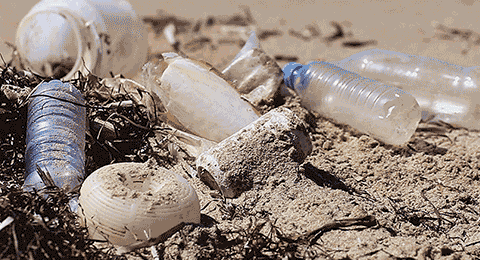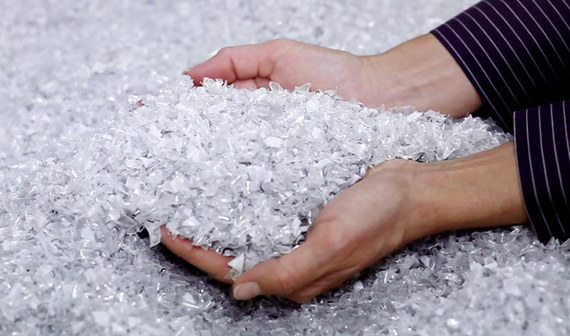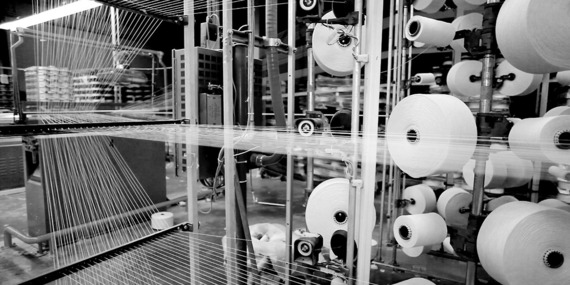Because plastic shopping bags are so widespread, it may
not occur to some younger shoppers that plastic bags have only been
around since the 1970s, a relatively short amount of time considering
how many centuries people have been bringing home purchases.
Mike Heimos, a stormwater educator for the city of
Columbia, said he was working as a bag boy in a St. Louis-area Schnucks
when the bags were first introduced to his store in the mid-1980s — a
time when the supermarket closed on Sundays and employees cleaned out
ashtrays affixed to shopping carts.
“I remember the pushback from customers,” Heimos said. “People liked paper.”
Heimos leads the Crawdads, Columbia’s stream team,
which enlists the help of hundreds of volunteers each year to tromp not
only through local streams, but through wooded areas and along roadways
scouring areas for litter.
In 2013, Heimos said, the team recruited 621 volunteers
who worked 43 cleanups and collected more than 4,400 pounds of litter
from clean-up sites. While the total payload does include some larger
items like spent tires, the three largest culprits are drink containers,
cigarette butts and plastic bags.
Plastic shopping bags may have been the new thing when
Heimos was a teenager, but that changed quickly. Plastic bags rose to
ubiquity in supermarkets and shops across the globe, and it’s not hard
to figure out why: they’re lightweight, durable and easy to carry.
A shopper returning home from a trip to the grocery
store can easily hold several bags in one hand while fumbling for keys
with the other. And after the groceries are unloaded, the bags can be
reused to line trash cans or pick up pet waste.
Over the last several years communities worldwide have
begun to see that the convenience of plastic bags comes with a cost:
many of the estimated 500 bags that an average consumer uses each year
end up in the landfill or in storm drains, waterways and, eventually,
the ocean.
“They end up downstream and they end up entangling
wildlife,” said Lawrence Lile, chairman of the city of Columbia’s
Environment and Energy Commission, which the Columbia City Council has
ordered to review a proposed ordinance to restrict the use of plastic
bags in the city.
The draft ordinance currently under the commission’s
consideration — which the Osage Group of the Sierra Club presented to
the council — would prohibit grocery stores, convenience stores,
pharmacies and farmers markets from providing plastic bags to customers.
Plastic bags would also be prohibited from distribution at
city-sponsored events.
Grocers would still be able to provide bags to prevent
produce or cuts of meat from coming into contact with other foods or
surfaces. Stores would also be able to offer paper bags but charge 10
cents each — revenue that grocers would be able to hang onto as long as
they can furnish receipts to prove that they are charging customers for
the bags.
BANISHING THE BAG
Plastic shopping bags — or “T-shirt” bags — are made of
high-density polyethylene, which is produced from oil and natural gas.
Plastic bags are not biodegradable, and thus break down into smaller and
smaller toxic bits that can contaminate soil or be ingested by
wildlife.
According to the U.S. Environment Protection Agency, in
2012, 1.4 billion pounds of bags were thrown into America’s waste
stream and about 7 percent of that amount was recycled. They can be
recycled to make composite lumber or more bags.
While a partial plastic bag ban may contribute to the
better health of local waterways, supporters in Columbia admit that the
policy would be no panacea for the larger problem of litter and waste.
Heimos, the city’s stormwater educator, said his stream
teams find plenty of other discarded junk that may have had a useful
second life.
“When you look at 95 percent of what we collect, it could have been recycled in the first place,” Heimos said.
One intent behind the proposed bag ban, supporters say,
is to wean customers off plastic shopping bags and get them to use
recyclable or reusable bags. As most already do voluntarily, grocers
would be required to offer reusable bags to customers.
Additionally, customers would be allowed to bring their
own bags to stores — even the plastic ones that grocers would no longer
be allowed to distribute — to carry out their groceries.
Many other types of retailers would be exempt from the
ban, including clothiers and gift shops, as would restaurants who give
out bags for take-out.
If approved, the ban would not go into effect for one
year. After that time, violators would be fined between $100 and $300
per offense. The city’s environmental commission is working on a report
for the city council on the proposal, but Lile said there is currently
no timeline in place for when they’ll release the report.
Jeanna Glaubitz, who lives near Midway just west of
Columbia, had just finished shopping at the West Broadway Gerbes and was
loading a bundle of plastic bags into the back of her automobile. She
said she reuses her plastic bags and that, while she finds them useful
in their second lives as trash-can liners, she could live with a ban on
bags in Columbia.
“I would be unnerved by it, but I would find a way,” Glaubitz said.
Blake Maples, a Columbia resident who was heading into
Gerbes on Wednesday, said he would support a ban. “Most progressive
cities have ended bags, period,” Maples said.
Columbia’s proposal to ban bags while charging a small
fee is one of several models communities have used to curtail the use of
plastic bags.
This year, California became the first state to enact a
statewide ban on plastic bags, though the state took its cue from local
communities: more than 100 California municipalities had passed bans of
their own.
Under California’s law, which goes into effect in July,
customers are charged 10 cents for recyclable paper bags, reusable
plastic bags and compostable bags. The law also provides $2 million in
competitive loans for companies to businesses seeking to manufacture
reusable bags.
Plastics manufacturers are currently funding a
referendum petition drive to suspend the law and put the issue before
California voters on the November 2016 ballot. Opponents have until Dec.
30 to submit a petition with more than 504,000 signatures.
According to Californians Against Waste, a
not-for-profit that advocates for bag bans, 58 cities outside of
California will have laws in effect as of April.
Nationwide, groups like the American Chemistry Council,
which represent plastics manufacturers, have fought against bans,
saying prohibitions would cost manufacturing jobs. The group argues that
some cities’ bans disproportionately affect low-income shoppers.
The American Chemistry Council did not respond to a request for comment.
Ken Midkiff, a member of the city commission, said he
suggested Columbia’s ban include a provision that would exempt customers
who use government assistance programs like Supplemental Nutrition
Assistance Program or the Women, Infants and Children nutrition program
from having to pay the 10-cent fee for paper bags.
A NUISANCE AT THE LANDFILL
The city of Columbia’s Solid Waste utility recycles No.
1 and No. 2 plastics, which includes plastic beverage containers, milk
jugs, shampoo bottles and detergents. But it does not recycle plastic
Nos. 3 through 7, nor does it recycle plastic film like shopping bags
and sleeves for newspapers.
The city’s blue recycling bags, like plastic shopping
bags and other materials, cannot be recycled at the city’s Material
Recovery Facility in northeast Columbia. They are buried in the
landfill.
Cynthia Mitchell, manager of the city’s Solid Waste
utility, said the blue bags are made of recyclable material, but said
they usually can’t be reused because they become contaminated or get
glass embedded into them.
But the Material Recovery Facility also has the problem
of not having the space to store enough plastic bags to recycle them in
a cost-effective way — they are light and airy and the city needs a lot
of them to be able to put them out on the market.
“There are a lot of things that could be recycled if we
had the space and the funding to sort it and process it,” said
Mitchell, who said Solid Waste urges residents to take plastic bags to
stores that offer bag recycling.
In a recent afternoon in the 5,000-square-foot recovery
facility, material handlers on the ground floor rip open the blue
recycling bags distributed to Solid Waste customers and feed the
contents onto a conveyer belt that takes the refuse up to a second
level. There, a second group of handlers pick out materials that pass
muster to be recycled.
Plastic bags are an pervasive presence around the
facility; they can be seen poking out of piles of materials or lightly
tumbling across the floor.
During a tour, Ken Bates, a supervisor at the facility,
surveyed a large pile of newspapers that was destined for Johnson
Products/Cell-Pak, which buys the newsprint to make insulation. He
plucked a plastic bag out of the pile, saying it could be the “kiss of
death” for the company’s machines.
Keeping unusable plastic out of the mix of materials
that the facility can sell to buyers, Bates said, “makes our job a lot
harder than it has to be.”
Plastic bags are gathered up and taken to the city’s
107-acre landfill just east of the facility to be buried with the rest
of the refuse.
On a recent windy day, Adam White, a bioreactor
specialist for the Columbia Public Works Department, took a reporter out
onto landfill cell No. 5, a 30-foot-tall mound of trash that — like the
rest of the landfill — has been shrouded in dirt, except one patch
where dirt had been moved aside and bulldozers, a dump truck and a
compactor were working to pile in that day’s trash pick-ups.
The work area was bounded by three litter fences, each
measuring 12 feet tall and 10 feet wide.The fences — each costing
between $3,000 and $5,000 each, White said, and the city’s Solid Waste
utility has six of them on hand — are placed around work sites to catch
lightweight debris that the heavy machinery and the stiff wind were
kicking up from the area.
“We have a lot of challenges with the scattering of
litter,” White said. He said that paper, styrofoam and plastic tend to
be the materials most likely to evade the screens and fly out of work
areas.
From there, the city relies on temp workers to chase
down the runaway trash. Leah Christian, a management fellow in City
Manager Mike Matthes’ office, said the the city spends about $45,000
annually on the temp workers and it is estimated that about one-third of
that amount is devoted to picking up plastic.
PAPER OR PLASTIC?
Grocery store chains with locations in Columbia
contacted for this story either did not respond to requests for comment
or, if reached, declined to take a position on the issue. But industry
groups representing retailers and grocers have expressed opposition to
the laws limiting bags.
“This will cost the consumer and will be an
inconvenience,” said David Overfelt, president of the Missouri Retailers
Association. Overfelt said the ban would limit consumers’ choices on
how they can carry their purchases from a store and that, comparatively
speaking, plastic bags cause less environmental harm than paper bags
because plastic bag production has a lower carbon footprint than paper
bag production.
Paul Weitzel, managing partner for Willard Bishop, a
Barrington, Ill.-based retail consulting firm, noted that some grocery
store chains are taking the environmentally-friendly approach and
ditching plastic bags.
But, Weitzel said, stores must also look at the
economic side of the situation: plastic bags cost stores about a
half-cent a piece right now, compared with about 6 1/2 cents a piece for
paper bags.
“The plastic bag is just so cheap right now,” he said.
While representatives for chain grocery stores
operating in Columbia demurred from offering an opinion about Columbia’s
proposed bag ban, they were willing to discuss their plastic bag
recycling programs.
Tara Deering-Hansen, a spokeswoman for Hy-Vee, said in
an email that, in the company’s 2013 fiscal year, its 230 stores
recycled more than 2 million pounds worth of plastic shopping bags. The
recycled materials, she said, was reused to make new plastic bags.
Gerbes also recycles the bags that customers bring back
to the store and uses the materials to make new bags, said Sheila
Lowry, a spokeswoman for Dillon Stores, which operates Gerbes. Since
September, she said, Dillon stores in Missouri, Kansas and Nebraska have
recycled 394 tons of plastic bags.
Lile, chairman of the Environment and Energy
Commission, said commission members are still weighing the pros and cons
of the proposal and meeting with some business owners to ensure the ban
would not unfairly burden some sectors of the population or particular
businesses.
“We want to make sure that local business owners understand why we’re doing this,” Lile said.








![The EU has agreed to curb the use of plastic bags in all member states.[Kerry Lannert/Flickr]](http://www.euractiv.com/files/styles/x-large/public/2459749579_eb262b6264_z.jpg?itok=y_byHeWu)








